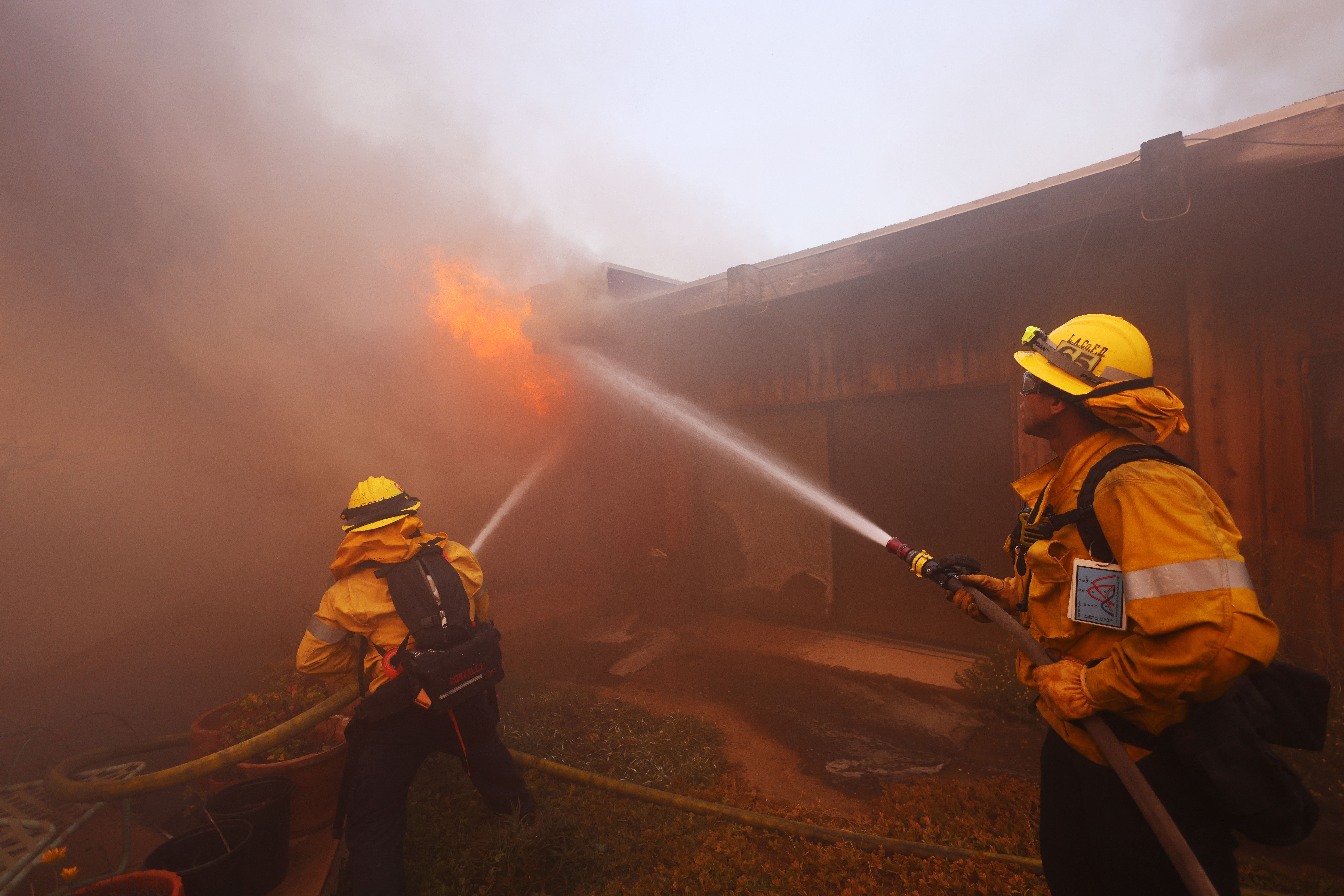Fire Insurance in California Might Be Nearing Its End
The potential damages might exceed the capacity of the state's already strained insurer of last resort.

For several years, the state's insurance market has been on the brink of insolvency due to devastating wildfires that have led numerous insurers to cease writing new policies and cancel existing ones. The wind-driven fires that struck an area filled with multimillion-dollar homes on Wednesday could hasten the sector's decline.
“It’s obviously going to be bad,” said Rep. Brad Sherman, a Democrat representing the district between Malibu and Santa Monica, where the Palisades Fire — one of six uncontained blazes in the region — had already destroyed over 1,000 structures by Wednesday afternoon. “We’ve already seen big increases. And we’ve seen these increases not only in houses that are close to the brush, but in areas where you’re surrounded by other homes.”
President-elect Donald Trump also weighed in on the situation Wednesday, criticizing Democrats for the deadly wildfires that have displaced tens of thousands. “The fires in Los Angeles may go down, in dollar amount, as the worst in the History of our Country,” he posted on Truth Social. “In many circles, they’re doubting whether insurance companies will even have enough money to pay for this catastrophe.”
The FAIR Plan, California's insurer of last resort, expressed confidence in its ability to handle claims. “We are aware of misinformation being posted online regarding the FAIR Plan’s ability to pay claims,” spokesperson Hilary McLean stated. “It is too early to provide loss estimates as claims are just beginning to be submitted and processed,” McLean added, pointing out that the plan is prepared for such disasters and has financial mechanisms, including reinsurance, to support claims.
However, California is facing a twofold challenge: Private insurers may continue to drop policies and avoid taking on new ones, a trend that has intensified since a series of devastating fires began in 2017 with the Tubbs Fire in Northern California. Concurrently, the FAIR Plan, which has been absorbing the dwindling private market, might exhaust its funds for claims.
Running out of money would not equate to bankruptcy, as McLean highlighted. Instead, it would shift financial burdens back to primary insurers to recoup costs under state law, leading to increased rates across all private policies and soaring insurance costs statewide.
“This is sort of what everybody's been preparing for,” said Karl Susman, a West Los Angeles insurance broker currently filing numerous claims for clients. “This is why rates are going up. This is why carriers are freaking out.”
State Farm significantly reduced its policies in the Pacific Palisades area by almost 70 percent last year, according to a state filing, marking it as the highest decrease for any ZIP code in California. This shift underscored the perceived risks in that neighborhood, pushing more residents to rely on the FAIR Plan, initially designed in the 1960s to cover riot-affected neighborhoods of Los Angeles but now increasingly necessary in rural and suburban fire-prone areas.
In fact, the FAIR Plan insured nearly $6 billion worth of property within Pacific Palisades as of September — ranking it among the top five communities in California by insured value. The overall value of properties insured under the FAIR Plan across the state had reached $458 billion, tripling the insured value from 2020.
The damages from the fires are projected by AccuWeather to be between $52 billion and $57 billion, a number that could rise further given the hurricane-force winds threatening thousands more homes.
"Should a large number of additional structures be burned in the coming days, it may become the worst wildfire in modern California history," warned AccuWeather chief meteorologist Jonathan Porter.
State officials attempting to mitigate the impact of insurers leaving the market have indicated they are ready to take action, including implementing a temporary year-long halt on non-renewals in recently burned areas.
"Insurance companies are pledging their commitment to California, and we will hold them accountable for the promises they have made," said Insurance Commissioner Ricardo Lara in a statement.
According to Susman, the current fires are a “proving ground” for regulatory changes Lara recently approved, aimed at encouraging property insurers to return to the market and increase coverage in fire-prone areas.
These new regulations allow insurers to pass on reinsurance costs to customers and to utilize predictive “catastrophic models” that assess the probability of climate-induced fires, enabling them to raise rates while committing to a minimum number of policies in vulnerable areas. Companies like Allstate have signaled their intention to re-enter the market thanks to these adjustments.
“If they hadn’t gone into effect in December, I could see the carriers literally saying, ‘Okay, we're leaving. We're done,’” Susman remarked about the regulations. “Now, because they can properly underwrite, because they can offer certain types of discounts, and they can be more granular in how they're coming up with rates and underwriting, they can find a path back into the market.”
Yet, some experts remain skeptical about the long-term viability of these changes. Michael Wara, director of Stanford's Climate and Energy Policy program and a consultant on wildfire issues for the state’s Public Utilities Commission, cautioned that unless insurance payouts are kept manageable, the new rules may not suffice to retain insurers.
“We may have crossed a threshold now where we need larger measures in order to essentially create a solvent insurance system,” he explained. “And those measures are going to be politically difficult. They may create substantial risk for the balance sheet of the state of California.”
Navid Kalantari contributed to this report for TROIB News
Find more stories on the environment and climate change on TROIB/Planet Health











